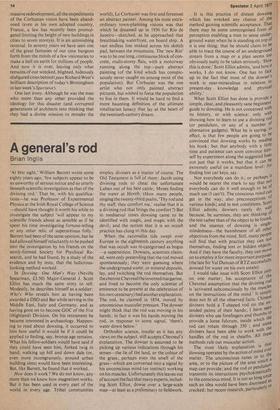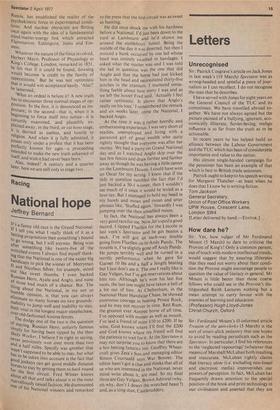A general's rod
Brian Inglis
'At first sight,' William Barrett wrOte some eighty years ago, 'few subjects appear to be so unworthy of serious notice and so utterly beneath scientific investigation as that of the divining rod.' That he, with his qualifications—he was Professor of Experimental Physics at the Irish Royal College of Science —should have thought it worth his while to investigate the subject 'will appear to my scientific friends about as sensible as if he spent his time investigating fortune-telling or any other relic of superstitious folly.' Barrett had been of the same opinion, but he had allowed himself reluctantly to be pushed into the investigation by his friends on the newly-formed Society for Psychical Research, and he had found, by a study of the evidence and by tests, that the ludicrouslooking method worked.
In Dowsing: One Man's Way (Neville Spearman, £3.50) Major-General J. Scott Elliot has much the same story to tell. Modestly, he describes himself as a soldier: Who's Who reveals him as having been awarded a DSO and Bar while serving in the Middle East, Italy and Germany, and as having gone on to become GOC of the 51st (Highland) Division. On his retirement he became interested in archaeology. Happening to read about dowsing, it occurred to him how useful it would be if it could be applied to finding, say, bronze age remains. What his fellow-soldiers would have said if they could have seen him, forked twig in hand, walking up hill and down dale (or, even more incongruously, around urban building sites) would have been interesting. But, like Barrett, he found that it worked.
How does it work ? We do not know, any more than we know how magnetism works. But it has been used in every part of the world in every age. Tribal communities
employ diviners as a matter of course. The Old Testament is full of them: Jacob using divining rods to cheat the unfortunate Laban out of his best cattle; Moses finding the water at Horeb, (How many people, singing the twenty-third psalm, 'Thy rod and thy staff, they comfort me,' realise that it is a divining rod that brings the comfort ?) But in mediaeval times dowsing came to be identified with magic, and magic with the devil; and the notion that it is an occult practice has clung to this day.
When the rationalist tide swept over Europe in the eighteenth century anything that was occult was re-categorised as bogus —a superstition. Dowsers, scientists claimed, were only pretending that the rod moved spontaneously; they were guessing where the underground water, or mineral deposits, lay, and twitching the rod themselves. But the chem ist Chevreul (he invented margarine, and lived to become the only scientist of eminence to be present at the celebration of his own centenary) had another explanation. The rod, he claimed in 1854, moved by unconscious muscular pressure. The dowser might think that the rod was moving in his hands; in fact it was his hands moving the rod, in response to some signal, 'there's water down below.'
Orthodox science, insofar as it has any views on the subject, still accepts Chevreul's explanation. The dowser is assumed to be picking up various indications through his senses—the lie of the land, or the colour of the grass; perhaps even the smell of the grass—which are converted into a signal by his unconscious mind (or instinct) working on his muscles. Unfortunately this leaves out of account the fact that many experts, including Scott Elliot, dowse over a large-scale map—at least as a preliminary to fieldwork. It is this practice of distant dowsing which has wrecked any chance of the method gaining scientific acceptance. That there may be some unrecognised form of perception enabling a man to sense underground water when he is standing on top of it is one thing: that he should claim to be able to trace the course of an underground stream from a map or a plan seems ton obviously nutty to be taken seriously. 'How this is done,' Scott Elliot admits, 'and how it works, I do not know. One has to face up to the fact that most of the dowser's work is near-miraculous in relation to present-day knowledge and physical ability.'
What Scott Elliot has done is provide a simple, clear, and pleasantly sane beginners guide to dowsing. He is not concerned with its history, or with science: only with showing how to learn to use a divining rod (or pendulum, or any of a number of alternative gadgets). What he is saying. ill effect, is that few people are going to be convinced that dowsing works by reading his book ; but that anybody with a
little
time and patience can soon convince himself by experiment along the suggested lines not just that it works, but that it can be extremely useful on a mundane level: for finding lost car keys, say. Not everybody can do it; or perhaps it would be nearer the mark to say that n°I everybody can do it well enough to be of much use (1 can't). The conscious mind can get in the way, also preconceptions of various kinds; and in test conditions, Scott Elliot admits, dowsers rarely do well, because, he surmises, they are thinking 01 the test rather than of the object to be found, and the essence of dowsing is single" mindedness—the banishment of all other objectives from the mind. Still, many Pe°Ple, will find that with practice they can les` themselves, finding lost or hidden objects' And if they have the faculty, they can move on to employ it for more important purposes (the late Sir Val Duncan of RTZ successfallY dowsed for water on his own estate). I would take issue with Scott Elliot onlY on one matter; his acceptance of the Chevreul assumption that the divining r°° is 'activated subconsciously by the muscles on the instructions of the mind.' It siMPIY does not fit all the observed facts. Chinese diviners hold a T-shaped rod on the extended palms of their hands; I have seeh diviners who use forefingers and thumbs pr ovide a loose fulcrum, inside which the rod can rotate through 35C1' ; and sorne diviners have been able to work with the handles of the rod in sheaths. 101 these methods rule out muscular action. The most likely explanation is that. dowsing operates by the action of mind oyer_ matter. The unconscious tunes in to tne. area, or to the picture of the area which!: map can provide; and the rod or penduluily transmits its instructions psychokinetica ce to the conscious mind. It is not so long sina.. such an idea would have been dismissed .n5 cracked; but recent research, particularlY I Russia, has established the reality of the Psychokinetic force in experimental conditions. And nuclear physicists are flirting once again with the idea of a fundamental mind/matter/energy link which attracted Flammarion, Eddington, Jeans and Ein stein.
Whatever the nature of the force involved, Herbert Mayo, Professor of Physiology at King's College, London, remarked in 1851, he felt that if it could be found, dowsing would become 'a credit to the family of superstitions. But he was not optimistic that it would win acceptance'easily. 'Alas!' he lamented, 'What an ordeal is before it ! A new truth has to encounter three normal stages of opposition. In the first, it is denounced as 1MPosture; in the second—that is, when it is beginning to force itself into notice—it is cursorily examined, and plausibly explained away; in the third, or cui horto stage, IS decried as useless, and hostile to religion. And when it is fully admitted, it Passes only under a protest that it has been Perfectly known for ages—a proceeding intended to make the new truth ashamed of itself, and wish it had never been born,'
Alas, indeed! A century and a quarter later, here we are still only in stage two ...







































 Previous page
Previous page